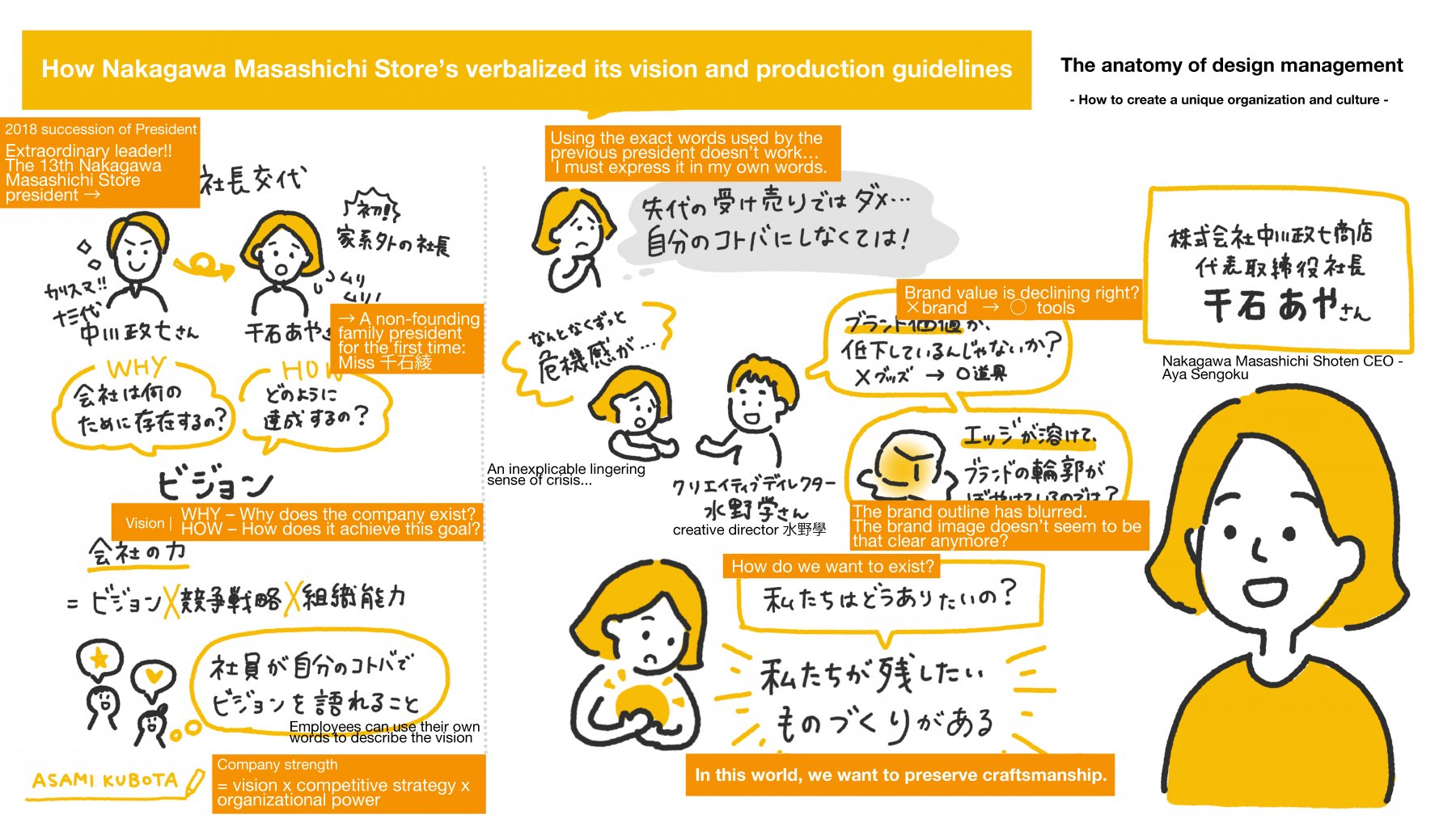
Anatomy of Design Management – How To Create A Unique Organization And Culture
In May 2018, The Patent Office Of Japan’s Ministry of Economy, Trade and Industry made a declaration urging Japanese companies to deepen design mentality with design management with the goal of reviving the Japanese industry.
Design Management refers not to visual design, but instead creates new management methods from the foundations of corporate culture, from designing a flat and highly flexible organization structure and talent development policy, harnessing cross-departmental collaboration to turn ideas into reality or creating an environment that accelerates business development.
On February 14, Loftwork Kyoto held a seminar titled, “The Anatomy of Design Management – How to Create a Unique Organization and Culture” with guest speakers from Nakagawa Masashichi Store and The Patent Office. Below is a summary of the day’s events.

Organizations that act through autonomy instead of labor

To kick off the event, one of the producers of Loftwork, Shiori Shinoda, described the approach Loftwork takes to design management. “To us, design is taking the core values of an organization and transforming them into something that is understandable, combining the hearts of both those inside and outside of the organization to create various strategies and methods,” Shiori said. Under this definition, coming up with research methods to discover problems and the rundown of a meeting are all considered “design.”
Loftwork, Shiori explained, is a project management team that helps companies and organizations to discover their strengths through the user’s perspective, put them to paper and then spread these new values.

“Loftwork values creating systems that aren’t bound by old and traditional values,” she said. Instead of hiring creators into the company, Loftwork finds suitable external partners based on the content of each case and forms a new tem. She explained that the reason for this is because communication between different kinds of people gives birth to new ideas and methods, which then allows Loftwork to produce content that breaks free of traditional frameworks to be introduced into organizations.
She went on to say that in design management, it’s important to look at a company as a collection of many individuals and work to inspire each person’s passion to create a corporate culture that isn’t built around labor but where every person in the company can act autonomously. Different perspectives and diverse values can then collide to create a lively community that becomes an organic and fertile breeding ground for various interesting projects.
Related case study: SAKAE Creative Meeting
In her opening, Shiori spoke about the SAKAE Creative Meeting, a series of creative meetings hosted by department store chain Matsuzakaya and Loftwork to mobilize the resources, techniques, spaces, people and financial support of the Chūbu region. Out of this, various project prototypes were born. Actively holding events and gradually establishing an inclusive community that allows people in different fields to communicate freely is also one of the ways Loftwork practices design management. See case study here. (Available in Japanese only)
Applying Design Management to a corporation’s organizational management
After this, Aya Sengoku , the president of Nakagawa Masashichi Store and Masatoki Toyama from the Patent Office’s Design Management team were invited to share their experiences with design management. Aya Sengoku spoke about an organizational structure that instills the corporate vision deep in the hearts of its employees and encourages each employee to act independently, while Masatoki Toyama laid out design management strategies and practices for nurturing talent from the bottom up.
Everything starts from the vision. Without ideas, design doesn’t exist.
“Nakagawa Masashichi Store was founded in 1716 as a hemp cloth business. Faced with the changing times and multiple crises, the company was only able to survive until today by relying on breakthroughs in frameworks and continuous reformation.” said Aya Sengoku, who became the company’s 14th president in 2018 as well as the first person outside of the Nakagawa Masashichi family to hold the position.
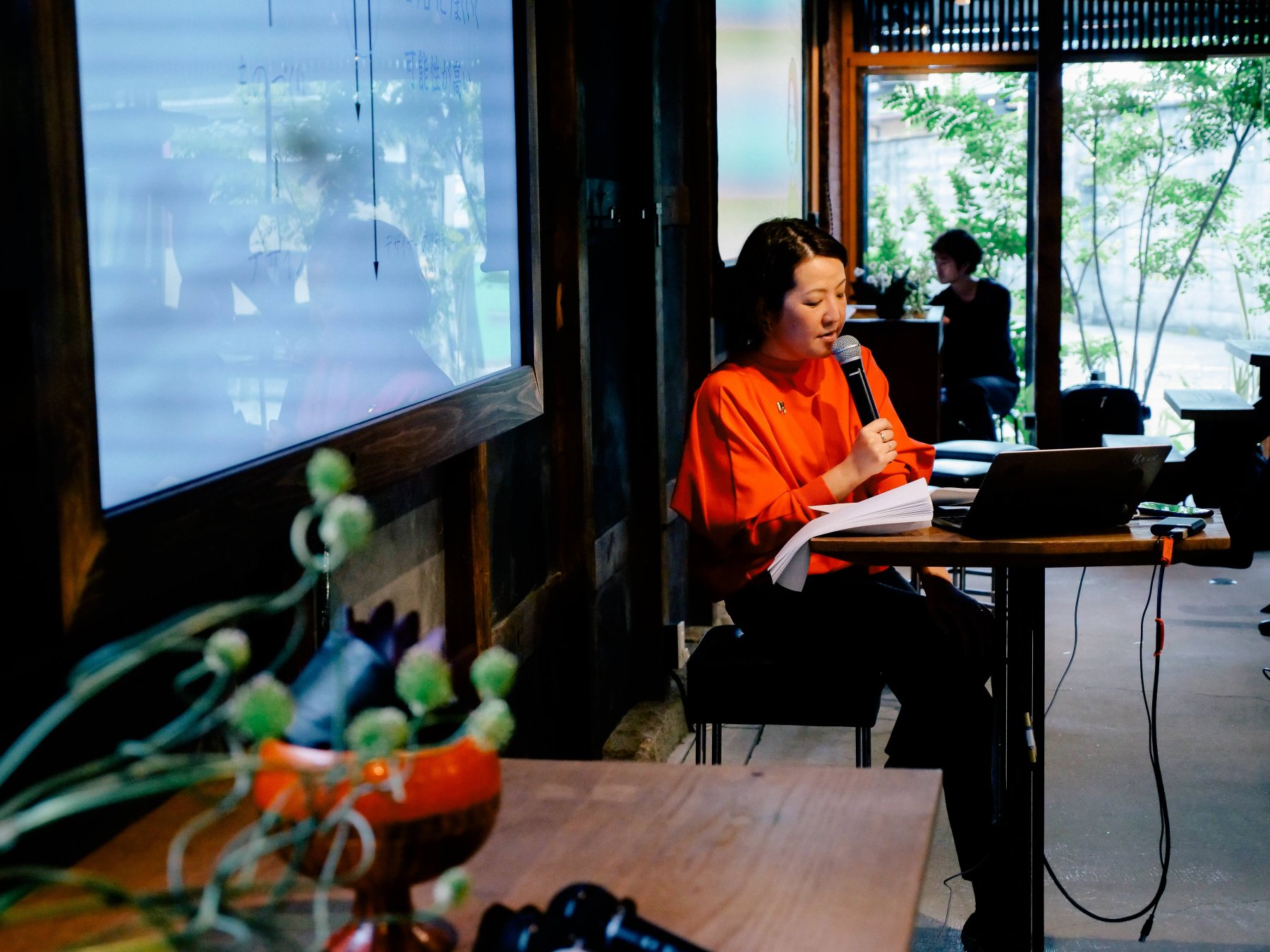
The Nakagawa Masashichi Store business is mainly focused on the planning, manufacture and retail of Japanese crafts. The business underwent a change in management policy under the 13th president, who increased the wholesale business by 70 percent and transferred retail work to direct stores. Realizing it was impossible to establish a brand by simply selling goods to customers, he ushered in a period of transitioning from “creating products” to “creating a brand”.
In 2007, the company’s vision of “Bring Japanese Craftsmanship To Life!” was born. Prior to this, the company never had internal training in the family or formal management policies, but as various small manufacturers that it worked with began closing down, the company began to feel a sense of crisis and started pondering the question – “Are things okay as long as my business is booming? Should we be using our power to help the world of Japanese craftsmanship?”
After establishing the vision in 2007, Nakagawa Masashichi Store started actively making use of the experience and wisdom it had accumulated over the years, for example, by engaging in industry-specific management consulting work and more. “The benefits for our company are included in the vision,” Aya Sengoku said, adding that all the actions the company took were in service of realizing the vision.

“The strength of a company can be divided into competitive strategies and organizational capabilities. However, this is not enough,” she said. “After all, we must constantly ask ourselves – what does our company exist for? How does it achieve that goal? And in order to answer these questions, you need a vision.”
After Aya Sengoku become president, she decided she wanted to describe the vision in her own words and not just regurgitate the words of the former president. “Even though sales revenue was clearly very good at the time, I had an inexplicable lingering sense of crisis,” she said. Seeking clarity, she sought out creative director 水野學, who told her that Nakagawa Masashichi Store’s brand value was in the process of slowly declining. “To this day, I still remember when he said to me: ‘The outline of the company’s image seems to have blurred?’” she said.

Hoping to further internalize the company’s core values and visions and find the language she could use to describe both, Aya Sengoku eventually came to the phrase – “I want to preserve craftsmanship” – as a central tenet. “Japanese craftsmanship is gradually declining, but it’s a pity for some things to disappear. ‘We want to preserve craftsmanship’ – I discovered that this point is our core will,” she said.
“If we don’t let consumers know the philosophy and belief we place on our goods, they will not choose our products,” Aya Sengoku said. As a result, she was very focused on sharing the message and of turning the vision into powerful words that both company employees and the public could understand. “In order to achieve communication goals, you need to rely on the power of management and creativity. Employees who are literate in design, as well as design that factors in management levels, are indispensable,” she emphasized.
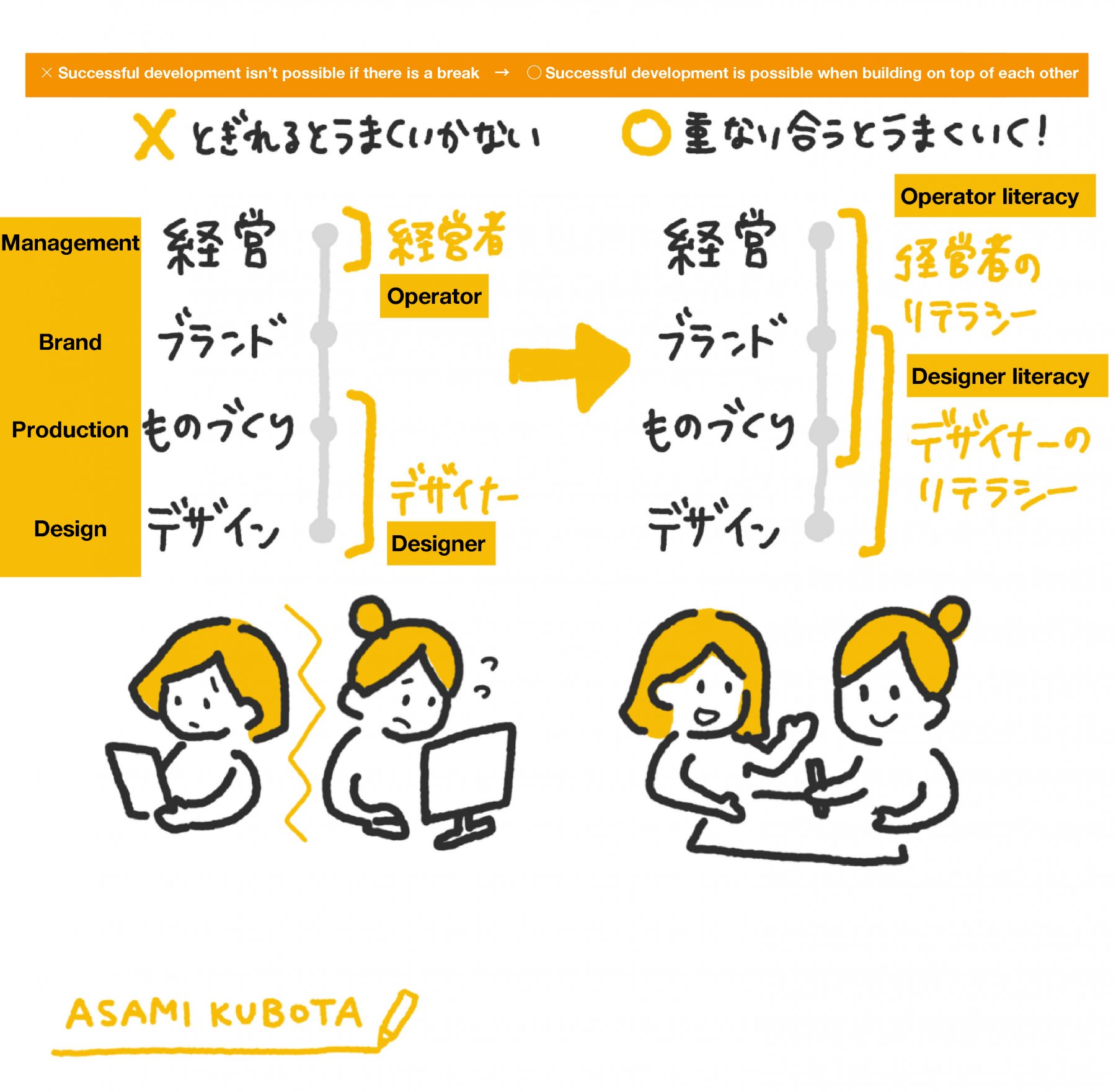
Treat design management a type of cultural promotion
Next up, Masatoki Toyama of the Patent Office’s Design Management team shared his journey of introducing design management into the organization and the challenges that it faces and will continue to face.

“Design management is an important resource that treats design as a way to elevate a company’s value and as a flexible way of management. It is divided into two aspects – design that helps build brands and design that helps innovation.”
To discover and solve the company’s problems, the Patent Office implemented several design management measures including utilizing the Double Diamond Model, hosting internal design thinking training, establishing a project room, creating a cross-department project team and more. Six teams with different project themes then launched in August 2018, using design management methods to solve the problems.
From the results, it became clear that inspiration and implementation were occurring at a quicker pace. “The announcement about design management brought momentum. The ethos of practicing design management gradually increased in the Patent Office,” he said.
To improve the design literacy of its employees, the Patent Office then held training sessions for young employees from each department. After the training, the young employees not only clearly expressed their own opinions to managers but also actively asked questions, which greatly moved management. It confirmed even more clearly to the Patent Office the desire to create an environment that could nurture such talent.
The task going forward, Toyama said, is to continue to build a new culture within the organization by translating this vision onto paper and applying it.
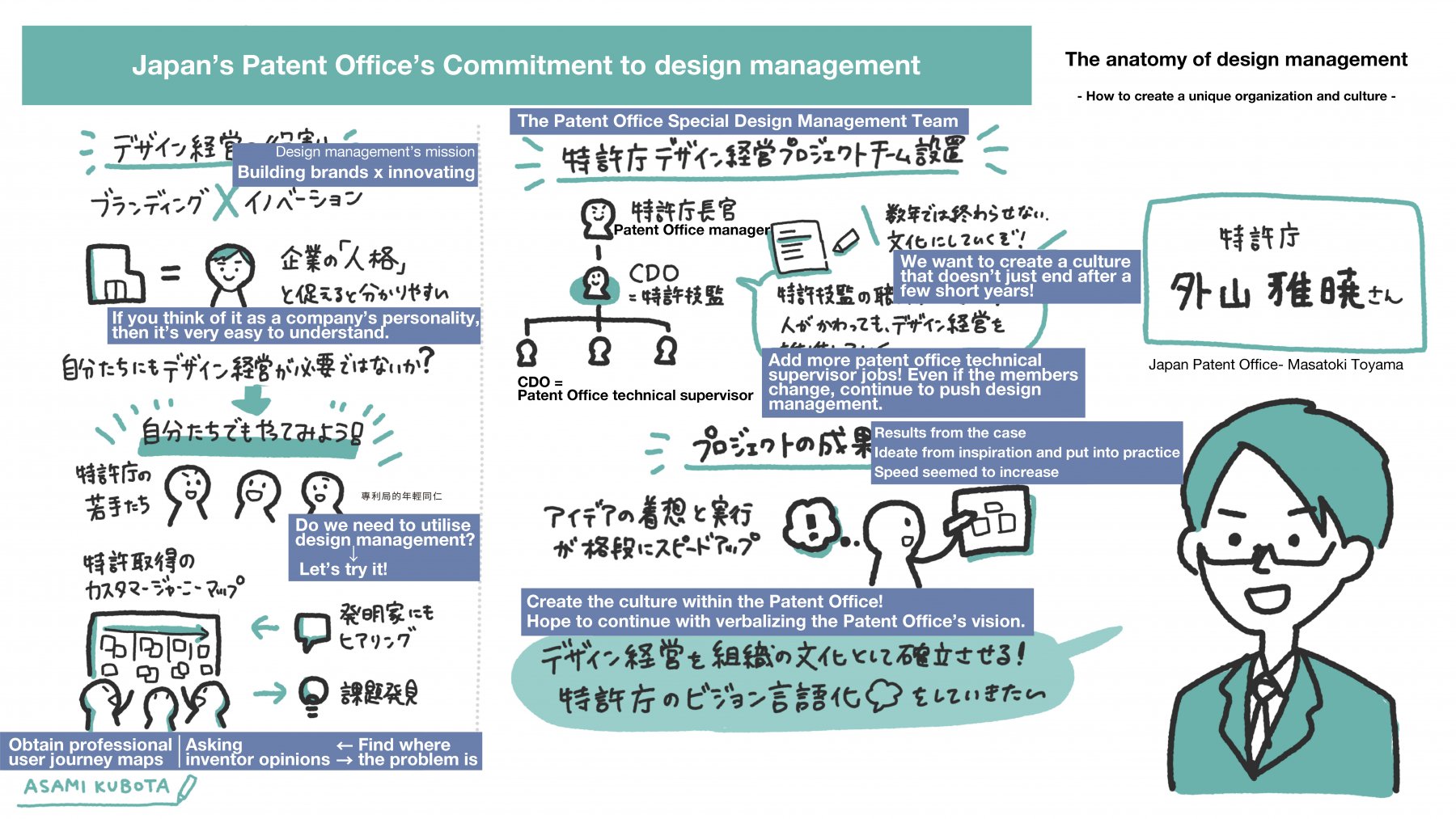
After conducting surveys and research, the Patent Office found that many companies are taking specific actions, such as tapping into the needs of customers, hiring and nurturing design talent, but at the same time, are coming up against several issues such as a lack of professional talent and understanding from senior and middle management about how to utilize design thinking. In addition, they also found that although many companies now recognize the importance of involving design leaders in business decisions, most of them have not taken any specific action on this point.
Based on the issues and solutions made clear from the research, the Patent Office organized its findings into two sections – first, a “guide” to encourage entrepreneurs to recognize the importance of design management, and second, “design management issues and solutions” that introduces the efforts that companies that have begun to adopt design management have undertaken and how to implement change.
Injecting design into organizational structure
After the guest speakers’ presentations, the audience then took part in a lively discussion and raised their questions and concerns, such as methods for introducing design management in performance reviews and how to get relatively conservative employees behind new modes of thinking.
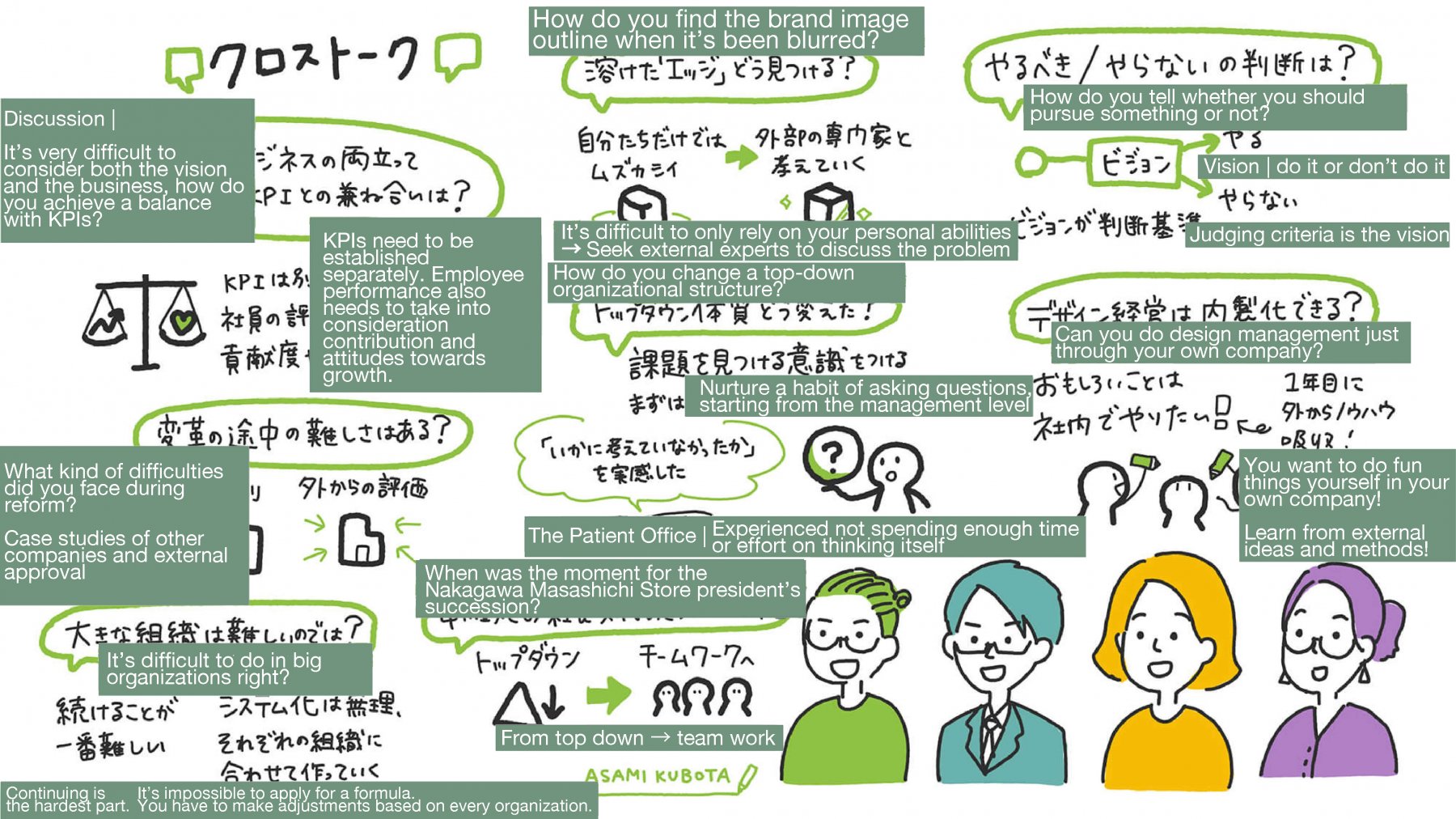
The KPI to achieve the goal should be set separately from the vision
The first question raised by the audience was how to balance design and business. In response to this, Aya Sengoku said that the KPIs to achieve goals should be set separately from the vision. Setting business goals is relatively easy if a company can help employees to recognize and understand the company’s vision from the moment they are hired, she said. The same is true for goals that are difficult to quantify; as long as employees have a deep understanding of the company’s vision, they can use methods such as measuring the difficulty of completing the task to help the business achieve its goals through mutual trust.
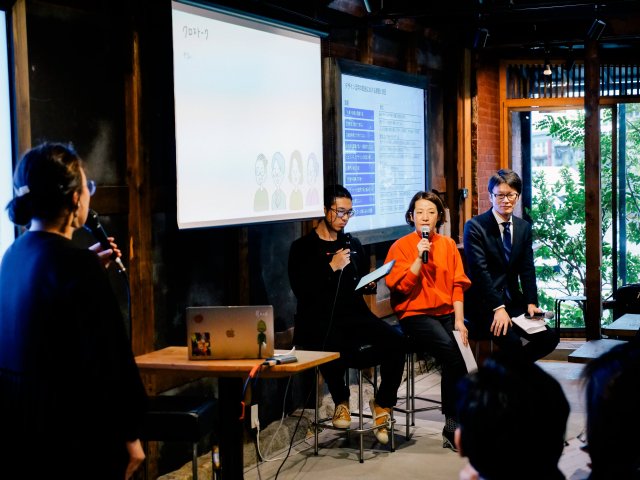
Breaking away from traditional top-down management systems
The audience then discussed the difficulty of switching into a design management model. The first step is to get rid of the traditional top-down management system, Aya Sengoku said. Then, institute measures to find problems that arise as a result of the belief that “teamwork starts from top to bottom.”
“After switching to a teamwork model, I found that although I had the ability to complete tasks after they were delegated, I wasn’t used to discovering problems, that is, seeing the difference that lies between the current and ideal statuses. Although the company’s vision has now been deeply ingrained in our employees’ hearts, we must continue to actively build a positive corporate culture.”
Toyama added that in a top-down system, the entire organization will gradually neglect to think. He said that although the project helped him understand the importance of design management, he also discovered that he hadn’t spent enough time nor effort on just thinking. “It is not only about being able to complete tasks efficiently, but thinking independently and having the ability to act autonomously,” he said. At present, the Patent Office is trying to develop a strategy that can implement design management measures as a kind of culture during the regular reorganization of employees.
How to use co-creation to change conservative organizations
How do you convince conservative members of a company to accept new ways of thinking? In response to this question, the two guest speakers stressed the importance of external affirmation and recognition.
Aya Sengoku said that Nakagawa Masashichi Store also faced the same problem; people in the company were initially reluctant to accept the vision, but when employees saw results of the consulting business in books and magazines and after products received the Good Design Award, they were more willing to accept and adopt the vision due to the external recognition.
After inviting external experts for assistance and learning relevant concepts and methods, the next step is to give the company the ability to take charge, she said. “Sometimes, it’s important to get recognition from the outside world, but it’s also about starting to take action and achieving results through your own efforts.”
“In order for the vision to become a collective goal that encourages employees to take action autonomously, it is necessary to let employees have thorough discussions so that more and more people can describe the company’s vision in their own words. This is not something that external resources can help with,” she said. Whether it is coming up with a method of identifying problems, building a brand or communicating the brand image, try to rely on yourself, she said.
Meanwhile, Toyama said that the Patent Office attaches great importance to shaping the vision from the bottom up and will open recruitment to find candidates with autonomy to enter the design management team.





